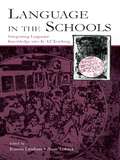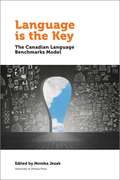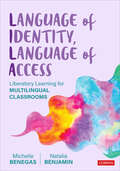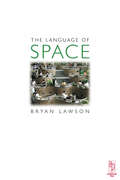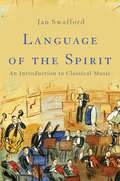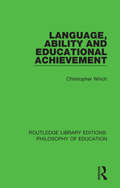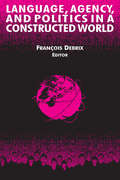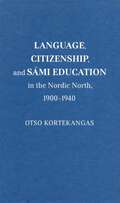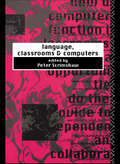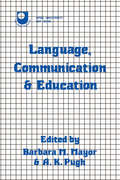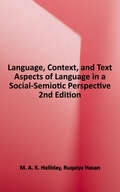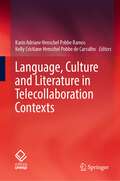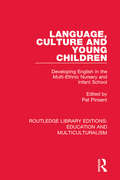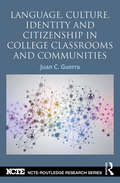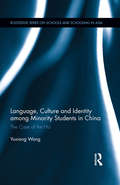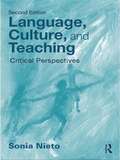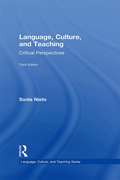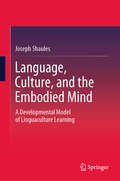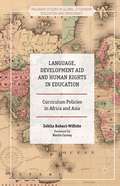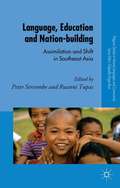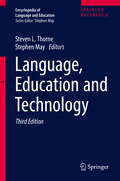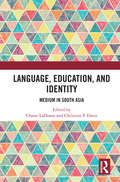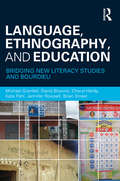- Table View
- List View
Language in the Schools: Integrating Linguistic Knowledge Into K-12 Teaching
by Kristin Denham and Anne LobeckLanguage in the Schools: Integrating Linguistic Knowledge Into K-12 Teaching addresses two important questions:*What aspects of linguistic knowledge are most useful for teachers to know?*What kinds of activities and projects are most effective in introducing those aspects of linguistic knowledge to K-12 students?The volume focuses on how basic linguistic knowledge can inform teachers' approaches to language issues in the multicultural, linguistically diverse classroom. The text also includes examples of practical applications of language awareness to pedagogy, assessment, and curriculum construction, which support the current goals of language arts, bilingual, and ESL education.Language in the Schools: Integrating Linguistic Knowledge Into K-12 Teaching contributes to the resources on linguistics and education by taking prospective teachers beyond basic linguistics to ways in which linguistics can productively inform their teaching and raise their students' awareness of language. It is intended as a text for students in teacher education programs who have a basic knowledge of linguistics.
Language is the Key: The Canadian Language Benchmarks Model (Politics and Public Policy)
by Monika JezakThe CLB/NCLC success was dependent on many factors—outstanding work by leading Canadian scholars; steady commitment of the government and non-governmental stakeholders at the federal, provincial, and local level; and, last but not least, unconditional commitment and caring on the part of an invested community of practice. Language is the key covers a range of topics: historical and political context that lead to the development of the Canadian standards, their current positioning in global educational markets, as well as their research and teaching cultures. This edited volume provides a comprehensive overview of recent and ongoing projects and of CLB- and NCLC-related materials, tools and resources for teaching and assessment. Finally, it offers a bold outlook, proposing various scenarios to branch out beyond these benchmarks into the domains of higher education, essential skills, literacy, workplace training, as well as international and indigenous languages. The 20th anniversary of the CLB/NCLC provides an opportunity to reflect on the scope and importance of this exceptional Canadian intellectual product.
Language of Identity, Language of Access: Liberatory Learning for Multilingual Classrooms
by Michelle Benegas Natalia BenjaminGrow students’ linguistic capital AND value their home language In Language of Identity, Language of Access, authors Michelle Benegas and Natalia Benjamin highlight the urgent need for a revolution in language education that validates home languages and dialects while equipping students with the linguistic tools for social mobility. Their original LILA framework rejects the socially constructed hierarchy of languages and provides students with a broader linguistic repertoire. This accessible and teacher-friendly guide presents an overview of this liberatory approach to language and literacy, an exploration of linguistically sustaining and expanding instruction, and practical guidance on designing lessons that attend to the language of identity and the language of access. Additional recurring features include: Voces provide real-life teacher experiences from the classroom Reflecciónes encourage educators to consider how principles and ideas relate to current practice and promote translanguaging Practical applications of theories (PATs) provide conceptual frameworks and lesson plans on various topics and activities. End of Chapter Conversaciónes encourage dialogue and enable educators to implement concepts in their classrooms. Offering a fresh perspective on academic language as a means to access power and social capital, Language of Identity, Language of Access is a guide for ALL educators committed to linguistically sustaining pedagogies and empowering students with linguistic capital for social mobility.
Language of Identity, Language of Access: Liberatory Learning for Multilingual Classrooms
by Michelle Benegas Natalia BenjaminGrow students’ linguistic capital AND value their home language In Language of Identity, Language of Access, authors Michelle Benegas and Natalia Benjamin highlight the urgent need for a revolution in language education that validates home languages and dialects while equipping students with the linguistic tools for social mobility. Their original LILA framework rejects the socially constructed hierarchy of languages and provides students with a broader linguistic repertoire. This accessible and teacher-friendly guide presents an overview of this liberatory approach to language and literacy, an exploration of linguistically sustaining and expanding instruction, and practical guidance on designing lessons that attend to the language of identity and the language of access. Additional recurring features include: Voces provide real-life teacher experiences from the classroom Reflecciónes encourage educators to consider how principles and ideas relate to current practice and promote translanguaging Practical applications of theories (PATs) provide conceptual frameworks and lesson plans on various topics and activities. End of Chapter Conversaciónes encourage dialogue and enable educators to implement concepts in their classrooms. Offering a fresh perspective on academic language as a means to access power and social capital, Language of Identity, Language of Access is a guide for ALL educators committed to linguistically sustaining pedagogies and empowering students with linguistic capital for social mobility.
Language of Space
by Bryan LawsonThis unique guide provides a systematic overview of the idea of architectural space. Bryan Lawson provides an ideal introduction to the topic, breaking down the complex and abstract terms used by many design theoreticians when writing about architectural space. Instead, our everyday knowledge is reintroduced to the language of design. Design values of 'space' are challenged and informed to stimulate a new theoretical and practical approach to design.This book views architectural and urban spaces as psychological, social and partly cultural phenomena. They accommodate, separate, structure, facilitate, heighten and even celebrate human spatial behaviour.
Language of the Spirit: An Introduction to Classical Music
by Jan SwaffordFor many of us, classical music is something serious-something we study in school, something played by cultivated musicians at fancy gatherings. In Language of the Spirit, renowned music scholar Jan Swafford argues that we have it all wrong: classical music has something for everyone and is accessible to all. Ranging from Gregorian chant to Handel's Messiah, from Vivaldi's The Four Seasons to the postmodern work of Philip Glass, Swafford is an affable and expert guide to the genre. He traces the history of Western music, introduces readers to the most important composers and compositions, and explains the underlying structure and logic of their music.Language of the Spirit is essential reading for anyone who has ever wished to know more about this sublime art.
Language, Ability and Educational Achievement (Routledge Library Editions: Philosophy of Education #20)
by Christopher WinchThis title, first published in 1990, engages in the current debates about the teaching of literacy and the reform of education. Based on his dissatisfaction with prevalent theories of educational achievement and his experience of teaching in elementary schools, Winch argues that the dichotomy of biological inheritance and environmental influence is inadequate to describe the diverse phenomena of educational achievement. This title will be of interest to students of the philosophy of education.
Language, Agency, and Politics in a Constructed World
by Francois DebrixLanguage matters in international relations. Constructivists have contributed the insight that global politics is shaped by the way agents narrate history and produce discourses about themselves and about the world. This insight has induced a profound reexamination of assumptions in the study of international relations. The contributors to this volume examine (Part I) the critical linguistic/discursive techniques of postmodernists and constructivists, and apply them (Part II) to international relations.
Language, Citizenship, and Sámi Education in the Nordic North, 1900-1940 (McGill-Queen's Indigenous and Northern Studies)
by Otso KortekangasIn the making of the modern Nordic states in the first half of the twentieth century, elementary education was paramount in creating a notion of citizenship that was universal and equal for all citizens. Yet these elementary education policies ignored, in most cases, the language, culture, wishes, and needs of minorities such as the indigenous Sámi.Presenting the Sámi as an active, transnational population in early twentieth-century northern Europe, Otso Kortekangas examines how educational policies affected the Sámi people residing in the northern parts of Norway, Sweden, and Finland. In this detailed study, Kortekangas explores what the arguments were for the lack of Sámi language in schools, how Sámi teachers have promoted the use of their mother tongue within the school systems, and how the history of the Sámi compares to other indigenous and minority populations globally.Timely in its focus on educational policies in multiethnic societies, and ambitious in its scope, the book provides essential information for educators, policy-makers, and academics, as well as anyone interested in the history of education, and the relationship between large-scale government policies and indigenous peoples.
Language, Classrooms and Computers (The\language And Education Library #Vol. 12)
by Peter ScrimshawAs computers become more widely used in schools, it is clear that they have the potential not just to support the achievement of conventional goals, but also to redefine what we mean by reading, writing and discussion. The contributors to Language, Classroom and Computers - all with experience of teaching about language and computers for The Open University - use teachers' accounts together with their own research to examine how the use of computers in school can affect the ways in which children learn and teachers teach. The first section looks at some generic aspects of computer use, focusing particularly on class management: individual and group learning, the role of the teacher as facilitator and co-learner and the problems of limited access. The second section examines the contribution of specific sorts of software package: word processing, e-mail, hypertext and so on to lanugage learning. This is a book for everyone who wants IT to add a new dimension to their teaching.
Language, Communication and Education
by Barbara M. Mayor A. K. PughExamines communication in the classroom within the larger context of the development of standard English and its social implications.
Language, Context, and Text: Aspects of Language in a Social-semiotic Perspective (Language Education Ser.)
by Ruqaiya Hasan M. A. K. HallidayThis study deals with the linguistic study of texts as a way of understanding how language functions in its immensely varied range of social contexts. The authors adopt a functional approach to language, in which the different registers or functional varieties of a language are explained by reference to the different contexts in which they occur. Their analysis reveals how, on the one hand, each text is unique, while on the other, the way a text is organized and the kinds of coherence it displays are closely related to the place and the value that it has in its social and cultural environment.
Language, Culture and Literature in Telecollaboration Contexts
by Karin Adriane Henschel Pobbe Ramos Kelly Cristiane Henschel Pobbe de CarvalhoThis book describes and analyses experiences of teaching and learning language, culture and literature based on telecollaboration, an approach that creates interactions between groups of learners from different countries through the integration of a series of virtual and intercultural collaborative tasks to the curricula of undergraduate and graduate courses. The experiences analyzed in this volume come from two telecollaborative projects developed by the São Paulo State University (UNESP), in Brazil, with universities from other countries: the Brazilian Virtual Exchange (BRaVE) Program and the Teletandem Brasil Project. The BRaVE Program aims at fostering an online collaborative learning modality that promotes intercultural contact and the exchange of ideas by connecting Brazilian undergraduate or graduate students with students from different higher education institutions around the world. The Teletandem Brasil Project is based on a mode of telecollaboration (teletandem) that creates a virtual, collaborative and autonomous context for learning foreign languages in which two students help each other to learn their own languages or a language of proficiency. They do so by using the text, voice and webcam image resources, and by adopting the three principles of tandem learning: autonomy, reciprocity, and separate use of both languages. Language, Culture and Literature in Telecollaboration Contexts will be of interest to both educational researchers and teachers as it presents, on the one hand, an innovative tool to promote the democratization of foreign language learning; and, on the other hand, discusses how telecollaborative projects can contribute to the training of language and literature teachers.
Language, Culture and Young Children: Developing English in the Multi-ethnic Nursery and Infant School (Routledge Library Editions: Education and Multiculturalism #8)
by Pat PinsentOriginally published in 1992. This book is designed to help the teacher facing the challenge posed by multi-ethnic, multi-cultural, multi-language classes. The contributions, from teachers and Higher Education tutors, are based on experience and research in this area and their emphasis is practical with theoretical support being provided where relevant. Part one considers issues of difference, including looking at oral language development, issues of assessment, and the particular needs of traveller children, among other topics. The second part looks at stories and books while the third looks at active language use in writing and drama. Part four suggests useful resources.
Language, Culture, Identity and Citizenship in College Classrooms and Communities (NCTE-Routledge Research Series)
by Juan C. GuerraLanguage, Culture, Identity and Citizenship in College Classrooms and Communities examines what takes place in writing classrooms beyond academic analytical and argumentative writing to include forms that engage students in navigating the civic, political, social and cultural spheres they inhabit. It presents a conceptual framework for imagining how writing instructors can institute campus-wide initiatives, such as Writing Across Communities, that attempt to connect the classroom and the campus to the students’ various communities of belonging, especially students who have been historically underserved. This framework reflects an emerging perspective—writing across difference—that challenges the argument that the best writing instructors can do is develop the skills and knowledge students need to make a successful transition from their home discourses to academic discourses. Instead, the value inherent in the full repertoire of linguistic, cultural and semiotic resources students use in their varied communities of belonging needs to be acknowledged and students need to be encouraged to call on these to the fullest extent possible in the course of learning what they are being taught in the writing classroom. Pedagogically, this book provides educators with the rhetorical, discursive and literacy tools needed to implement this approach.
Language, Culture, and Community in Teacher Education
by María Estela BriskPublished by Routledge for the American Association of Colleges for Teacher Education This volume addresses the pressing reality in teacher education that all teachers need to be prepared to work effectively with linguistically and culturally diverse student populations. Every classroom in the country is already, or will soon be, deeply affected by the changing demographics of America’s students. Marilyn Cochran-Smith’s Foreword and Donaldo Macedo’s Introductory Essay set the context with respect to teacher education and student demographics, followed by a series of chapters presented in three sections: knowledge, practice, and policy. The literature on language education has typically been discussed in relation to preparing ESL or bilingual teachers. Typically, needs of culturally and linguistically diverse students, including immigrants, refugees, language minority populations, African Americans, and deaf students, have been addressed separately. This volume emphasizes that these children have both common educational needs and needs that are culturally and linguistically specific. It is directed to the preparation of ALL teachers who work with culturally and linguistically diverse students. It not only focuses on how teachers need to change but how faculty and curriculum need to be transformed, and how to better train teacher education candidates to understand and work efficaciously with the communities in which culturally and linguistically diverse students tend to be predominant. The American Association of Colleges for Teacher Education (AACTE) is a national, voluntary association of higher education institutions and related organizations. Our mission is to promote the learning of all PK-12 students through high-quality, evidence-based preparation and continuing education for all school personnel. For more information on our publications, visit our website at: www.aacte.org.
Language, Culture, and Identity among Minority Students in China: The Case of the Hui (Routledge Series on Schools and Schooling in Asia #3)
by Yuxiang WangThis book explores Hui (one of the Muslim minority groups in China) students’ lived experiences in an elementary school in central P. R. China from the perspectives of philosophical foundations of education and the sociology of education, the impact of their experiences on their identity construction, and what schooling means to Hui students. The book describes a vivid picture of how the Hui construct their own identities in the public school setting, and how the state curricula, teachers, and parents play roles in student identity construction. The objectives of the book are to discover factors that impact Hui students’ identity construction and have caused Hui students to know little about their own culture and language; and to explore what should be done to help teachers, administrators, and policy makers appreciate minority culture and include minority culture and knowledge in school curriculum in order to meet the needs of Hui students.The book provides historical, policy, and curricular contexts for readers to understand Hui students’ experiences in central China, and discusses the cultural differences between Han and Hui from a philosophical level. The book uses postcolonial theory to critique the assimilative nature of school education, the construction of Hui students’ identity from Han ideology, and the cultural hegemony of the mainstream Han group. It also discusses curriculum reconceptualization both in China and globally, and the possibility of multicultural education in China.
Language, Culture, and Teaching
by Sonia NietoDistinguished multiculturalist Sonia Nieto speaks directly to current and future teachers in this thoughtful integration of a selection of her key writings with creative pedagogical features. Offering information, insights, and motivation to teach students of diverse cultural, racial, and linguistic backgrounds, this text is intended for upper-undergraduate and graduate-level students and professional development courses. Examples are included throughout to illustrate real-life dilemmas about diversity that teachers face in their own classrooms; ideas about how language, culture, and teaching are linked; and ways to engage with these ideas through reflection and collaborative inquiry. Each chapter includes critical questions; classroom activities; and community activities suggesting projects beyond the classroom context. Over half of the chapters are new to this edition, bringing it up-to-date in terms of recent educational policy issues and demographic changes in our society.
Language, Culture, and Teaching: Critical Perspectives (Language, Culture, and Teaching #23)
by Sonia NietoDistinguished multiculturalist Sonia Nieto speaks directly to current and future teachers in this thoughtful integration of a selection of her key writings with creative pedagogical features. Offering information, insights, and motivation to teach students of diverse cultural, racial, and linguistic backgrounds, examples are included throughout to illustrate real-life dilemmas about diversity that teachers face in their own classrooms; ideas about how language, culture, and teaching are linked; and ways to engage with these ideas through reflection and collaborative inquiry. Designed for upper-undergraduate and graduate-level students and professional development courses, each chapter includes critical questions, classroom activities, and community activities suggesting projects beyond the classroom context. Language, Culture, and Teaching • explores how language and culture are connected to teaching and learning in educational settings; • examines the sociocultural and sociopolitical contexts of language and culture to understand how these contexts may affect student learning and achievement; • analyzes the implications of linguistic and cultural diversity for classroom practices, school reform, and educational equity; • encourages practicing and preservice teachers to reflect critically on their classroom practices, as well as on larger institutional policies related to linguistic and cultural diversity based on the above understandings; and • motivates teachers to understand their ethical and political responsibilities to work, together with their students, colleagues, and families, for more socially just classrooms, schools, and society. Changes in the Third Edition: This edition includes new and updated chapters, section introductions, critical questions, classroom and community activities, and resources, bringing it up-to-date in terms of recent educational policy issues and demographic changes in the U.S. and beyond. The new chapters reflect Nieto’s current thinking about the profession and society, especially about changes in the teaching profession, both positive and negative, since the publication of the second edition of this text.
Language, Culture, and the Embodied Mind: A Developmental Model of Linguaculture Learning
by Joseph ShaulesThere is an odd contradiction at the heart of language and culture learning: Language and culture are, so to speak, two sides of a single coin—language reflects the thinking, values and worldview of its speakers. Despite this, there is a persistent split between language and culture in the classroom. Foreign language pedagogy is often conceptualized in terms of gaining knowledge and practicing skills, while cultural learning goals are often conceptualized in abstract terms, such as awareness or criticality.This book helps resolve this dilemma. Informed by brain and mind sciences, its core message is that language and culture learning can both be seen as a single, interrelated process—the embodiment of dynamic systems of meaning into the intuitive mind. This deep learning process is detailed in the form of the Developmental Model of Linguaculture Learning (DMLL). Grounded in dynamic skill theory, the DMLL describes four developmental levels of language and culture learning, which represents a subtle, yet important shift in language and culture pedagogy. Rather than asking how to add culture into language education, we should be seeking ways to make language and culture learning deeper—more integrated, embodied, experiential and transformational. This book provides a theoretical approach, including practical examples, for doing so.
Language, Development Aid and Human Rights in Education: Curriculum Policies In Africa And Asia (Palgrave Studies In Global Citizenship Education And Democracy Ser.)
by Zehlia Babaci-WilhiteThe debate about languages of instruction in Africa and Asia involves an analysis of both the historical thrust of national government and also development aid policies. Using case studies from Tanzania, Nigeria, South Africa, Rwanda, India, Bangladesh and Malaysia, Zehlia Babaci-Wilhite argues that the colonial legacy is perpetuated when global languages are promoted in education. The use of local languages in instruction not only offers an effective means to contextualize the curriculum and improve student comprehension, but also to achieve quality education and rights in education.
Language, Education and Nation-building
by Peter Sercombe Ruanni TupasThis volume tracks the complex relationships between language, education and nation-building in Southeast Asia, focusing on how language policies have been used by states and governments as instruments of control, assimilation and empowerment. Leading scholars have contributed chapters each representing one of the countries in the region.
Language, Education and Technology
by Stephen May Steven L. ThorneIn this third, fully revised edition, the 10 volume Encyclopedia of Language and Education offers the newest developments, including an entirely new volume of research and scholarly content, essential to the field of language teaching and learning in the age of globalization. In the selection of topics and contributors, the Encyclopedia reflects the depth of disciplinary knowledge, breadth of interdisciplinary perspective, and diversity of socio-geographic experience in the language and education field. Throughout, there is an inclusion of contributions from non-English speaking and non-western parts of the world, providing truly global coverage. Furthermore, the authors have sought to integrate these voices fully into the whole, rather than as special cases or international perspectives in separate sections. The Encyclopedia is a necessary reference set for every university and college library in the world that serves a faculty or school of education, as well as being highly relevant to the fields of applied and socio-linguistics. The publication of this work charts the further deepening and broadening of the field of language and education since the publication of the first edition of the Encyclopedia in 1997 and the second edition in 2008.
Language, Education, and Identity: Medium in South Asia
by Chaise LaDousa; Christina P. DavisThis book examines medium of instruction in education and studies its social, economic, and political significance in the lives of people living in South Asia. It provides insight into the meaning of medium and what makes it so important to identity, aspiration, and inequality. It questions the ideologized associations between education and social and spatial mobility and discusses the gender- and class-based marginalization that comes with vernacular-medium education. The volume also considers how policy measures, such as the Right to Education (RTE) Act in India, have failed to address the inequalities brought by medium in schools, and investigates questions on language access, inclusion, and rights. Drawing on extensive fieldwork and in-depth interviews, the book will be indispensable for students and scholars of anthropology, education studies, sociolinguistics, sociology, and South Asian studies. It will also appeal to those interested in language and education in South Asia, especially the role of language in the reproduction of inequality.
Language, Ethnography, and Education: Bridging New Literacy Studies and Bourdieu (Real Language Ser.)
by Jennifer Rowsell Kate Pahl Michael Grenfell David Bloome Brian V Street Cheryl HardyThis frontline volume contributes to the social study of education in general and literacy in particular by bringing together in a new way the traditions of language, ethnography, and education. Integrating New Literacy Studies and Bourdieusian sociology with ethnographic approaches to the study of classroom practice, it offers an original and useful reference point for scholars and students of education, language, and literacy wishing to incorporate Bourdieu’s ideas into their work. More than just a set of stand-alone chapters around social perspectives on language interactions in classrooms, this book develops and unfolds dialogically across three sections: Bridging New Literacy Studies and Bourdieu – Principles; Language, Ethnography and Education - Practical Studies; Working at the Intersections – In Theory and Practice. The authors posit ‘Classroom Language Ethnography’ as a genuinely new perspective with rich and developed traditions behind it, but distinct from conventional approaches to literacy and education — an approach that bridges those traditions to yield fresh insights on literacy in all its manifestations, thereby providing a pathway to more robust research on language in education.
